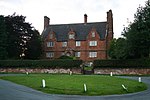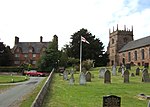Aqualate Hall
Buildings by W. D. CaröeGardens in StaffordshireGrade II* listed buildings in StaffordshireHouses completed in 1930Houses completed in the 16th century ... and 1 more
Houses completed in the 17th century

Aqualate Hall, a 20th-century country house, is located in Forton, Staffordshire, England, some 2 miles (3.2 km) east of the market town of Newport, Shropshire and 10 miles (16 km) west of the county town of Stafford. It is a Grade II* listed building.
Excerpt from the Wikipedia article Aqualate Hall (License: CC BY-SA 3.0, Authors, Images).Aqualate Hall
Newport Road,
Geographical coordinates (GPS) Address External links Nearby Places Show on map
Geographical coordinates (GPS)
| Latitude | Longitude |
|---|---|
| N 52.7745 ° | E -2.3363 ° |
Address
Aqualate Hall
Newport Road
ST20 0EE
England, United Kingdom
Open on Google Maps







